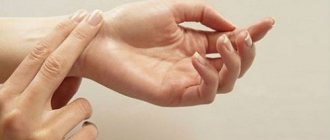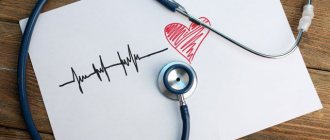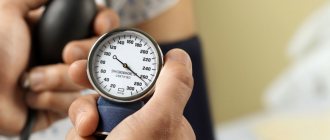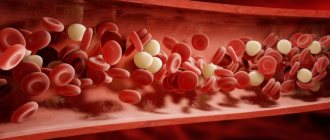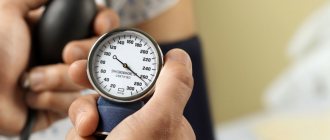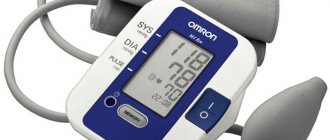The pulse can tell whether a person has any disease and help identify problems with the heart. Anyone can determine the frequency of beats. To do this, it is enough to have basic skills and basic knowledge of counting.
The heart rate in adults must be within certain limits (norms), deviation from which is grounds for visiting a doctor. You cannot diagnose yourself and self-medicate.
Today we will talk about the normal pulse rate in men and what a deviation from these norms indicates.
What should an adult man's pulse be?
Pulse is the number of rhythmic vibrations of the walls of the arteries and vessels of the body associated with the work of the heart muscle to circulate blood in the body over a given period of time. Simply put, this is the number of heart beats in one minute. Determining heart rate (HR) is necessary to monitor the activity of the heart and detect problems in its functioning.
In an adult man, the normal heart rate (HR) is 60-70 beats per minute. General indicators for humans allow a maximum rate of 80 blows.
Main factors influencing heart rate:
- gender of the person (pulse rates in women are higher than in men);
- age (in children the heart rate is higher than in adults);
- height (in a tall person, the heart beats less often);
- physical condition (an athlete’s resting heart rate is lower than that of an ordinary person);
- time of day (heart rate is reduced during night sleep, as well as for an hour before and after it).
What should a person's pulse be?
04.10.2021
Every person knows what a pulse is. Most people also know that the normal heart rate is 68-72 beats per minute. However, adjustments should be made here for age and other individual characteristics of the human body. For example, the heart rate of a small child is 2 times higher than that of an adult.
How to measure pulse correctly?
First of all, before you start measuring your heart rate, you should consider the time of day. So, its lowest readings will be observed early in the morning and late in the evening. But at the same time, in the evening (after work) the heart rate is highest.
Also pay attention to the position in which you measure your pulse. If you do this lying down or standing, then its value will be an order of magnitude lower than normal.
To measure your pulse, it is not necessary to count the beats for 1 minute. It is enough to do this for 30 seconds, and then multiply the resulting value by 2.
Do not measure pulse:
- after eating or drinking alcohol;
- on empty stomach ;
- after physical or mental stress, massage , bath, sauna and sexual intercourse;
- after exposure to frost or sun;
- on menstruation days in women;
- with lack of sleep;
- during systemic illness.
If you measure your pulse in the presence of one of the above readings, then its value will not be entirely correct, and then it will be inappropriate to judge any deviation in health.
Low heart rate and its causes
If you regularly measured your pulse (at the same time) and came to the conclusion that your pulse is low, then you need to deal with this situation. Below is a list of possible reasons.
Predisposing factors:
- physiological. Here we need to talk about the fact that some people have a constantly low heart rate, and at the same time they feel quite normal. However, it is still important to be examined for the presence of heart in order to exclude them;
- pathological bradycardia, the cause of which is a disruption of the conduction system of the heart ;
- organic heart : ischemic ( coronary heart disease ), atherosclerosis of the coronary vessels , myocarditis ;
- endocrine disorders;
- diseases of the nervous system , stress;
- intoxication;
- infections;
- increased intracranial pressure;
- taking certain medications.
Do not forget that measuring your heart rate is inextricably linked with the process of measuring blood pressure.
Often it is low blood pressure that leads to a low heart rate. Therefore, medications aimed at increasing blood pressure will help you here. But they should be selected exclusively by the attending physician - self-medication is unacceptable.
If we consider folk remedies, then tonic drinks, for example, green or black tea with ginger, and natural coffee, have proven themselves well.
Guarana and ginseng help stabilize the heartbeat. But remember that they are absolutely contraindicated for high blood pressure.
You should not drink Coca-Cola as it contains caffeine. In addition, it contains enough sugar, which provokes the development of diabetes , not to mention how this drink affects the condition of the gastric .
High heart rate in a person
Now let's talk about high heart rate. The reasons for its occurrence have a wider range. For example, the heart rate is increased after physical activity. If it increases significantly, then reconsider your training program by including cardio exercises and changing the strength regime. As a rule, trainers in gyms are consulted here.
An elevated heart rate can be a consequence of taking certain medications and is usually one of the side effects. In this case, tell your doctor about your complaints, and he, in turn, will either select an analogue or reduce the dosage of the medicine you are taking.
To return your heart rate to normal, it is important to give up bad habits, which play an important role. First of all, your risk of developing cardiovascular disease will be reduced.
If your heart rate is above 90 beats per minute at rest, then there is a chance that you will be diagnosed with tachycardia . It is important to find out the reasons for its development from a cardiologist , and then choose the right treatment. Having cured tachycardia , you will forget about both high blood pressure and increased heart rate.
As you can see, the value of the pulse rate can tell a lot, and therefore this indicator needs to be regularly monitored, not forgetting, of course, about measuring blood pressure levels.
Published in Cardiology Premium Clinic
What does the heart rate show in men?
The number of heart beats per minute, as well as their rhythm, indicate the quality of the cardiovascular system in a man. Heart rate indicators and its features enable an experienced doctor to assess the degree of a person’s health, taking into account his age and gender.
The nature of the heart rhythm indicates possible diseases and differs as follows:
- tachycardia (rapid heartbeat - more than 90 beats/min.). This is a symptom of disorders of the ANS, endocrine system, hemodynamics or other forms of arrhythmia;
- bradycardia (slow heartbeat - less than 50 beats/min.). This is a symptom of changes in the myocardium, increased intracranial pressure, lead or nicotine poisoning, hypothyroidism, fasting, cold, or typhoid fever;
- arrhythmia is a violation of the rhythm and frequency of heart contractions. Indicates heart defects, myocarditis, complications after taking medications, abnormalities in electrolyte balance, poisoning. It is often a consequence of heart failure - a disorder of cardiac activity leading to insufficient blood supply to the organs and tissues of the body.
Features of bradycardia
A slowing of the heart rate to 50 beats or below is called bradycardia. It is a sign of physiological and pathological factors. In the first case, the list of reasons for a decrease in heart rate is as follows:
- During sleep, a person's metabolism slows down, body temperature drops slightly and heart rate decreases by about 10% of normal. The reason for the change in indicators is the complete relaxation of the body.
- Stimulating reflex zones (eyeballs, carotid artery) can inadvertently cause a slight slowing of the pulse.
- In older people, bradycardia can be a consequence of age-related cardiosclerosis. Areas of connective tissue scattered throughout the myocardium impair cardiac contractility, which contributes to a decrease in heart rate
- When exposed to cold for a long time, the heart rate slows down as a protective reaction. The body begins to save resources in order to resist adverse effects longer.
- Constant physical activity forces the heart to work harder than it should. Tissue hypertrophy begins, against the background of which bradycardia develops. For professional athletes, a heart rate in the region of 40-45 beats per minute is considered normal.
The pathological form of bradycardia is a consequence of the following factors:
- inflammatory diseases of the heart muscle;
- myocardial infarction;
- taking antihypertensive medications;
- impulse conduction disturbance;
- hypothyroidism (thyroid hormone deficiency);
- hypotension (low blood pressure);
- stomach ulcer;
- high intracranial pressure.
If it is not possible to identify the causative factor, a diagnosis of “idiopathic bradycardia” is made. If it is not accompanied by other disorders and the symptoms are not particularly pronounced, then it is also equated to physiological forms.
Where is the best place to measure your pulse?
The most convenient place for measuring the pulse is the wrist, on which the radial artery is located. You need to place your index and middle finger on this artery. You cannot apply other fingers, because it is easy to confuse the pulsations of their vessels with contractions of the artery on the wrist.
There are some objective reasons for high heart rate in men, which can distort the correct indicators characteristic of a particular person. So, you cannot measure your pulse:
- for infectious diseases and high body temperature;
- after active sports and other physical activities;
- when taking medications;
- after bath procedures, visiting a sauna and a hot shower;
- during alcohol intoxication;
- after sexual intercourse;
- after prolonged exposure to high or low temperatures;
- on a full stomach.
Pathological causes
The heart rate can vary in one direction or the other due to pathological changes in the body. We are talking about six main diseases.
- Algorithms for measuring respiratory rate, pulse and blood pressure in children
Hypothyroidism
Hypothyroidism is a deficiency of thyroid hormones and the reverse process is hyperthyroidism with an excess of substances in the bloodstream. Hemodynamic disturbances affect the third reflex zone of the heart.
In the first situation, tachycardia occurs, in the second - a decrease in heart rate per minute. Prolonged course of both conditions is associated with an increased risk of fatal or disabling complications.
Diabetes
Generally destroys organs and systems, right down to the visual analyzer. With endocrine pathology, the heart wears out faster; without proper treatment, natural death occurs 10-15 years ahead of schedule.
Diabetes of the first type is especially dangerous, since it is not treated, but only corrected with medication, and not always to a sufficient extent.
Hypercortisolism or Addison's disease (reverse phenomenon)
Impaired synthesis of cortisol and other corticosteroids (to a lesser extent). Maintenance hormonal therapy and surgery to eliminate the root cause are required (in the vast majority of cases, the main factor is a tumor in the adrenal glands or pituitary gland).
Congestive heart failure
Causes cardiac ischemia and accelerates the rhythm, sometimes to significant levels. The course without therapy entails a heart attack, sooner or later (usually within 3-5 years from the onset of the first symptoms, by which time the disease is far from at the initial stage of development).
The first signs of heart failure are described in this article.
- Why calculate your heart rate if you decide to play sports?
Acute myocardial ischemia
Leads to death in 35-50% of cases. An extensive type of heart attack is fatal in 95% of clinical situations. Arrhythmia is the hallmark of the process, along with accompanying manifestations.
How to quickly increase your heart rate?
If a rare pulse is not a symptom of heart disease and appears for physiological reasons, you can speed it up and eliminate unpleasant symptoms by using simple remedies available in almost every home. Before starting activities, it is important to take into account the circumstances under which the heart rate decreased.
| Initiating factor | How and with what is it manifested? |
| Stress, shock, nervous disorders | If the heart rate decreases to forty beats per minute or below, you can take sedatives:
|
| Decreased blood pressure and pulse | The best option is to take decoctions for:
|
| Increased blood pressure and decreased heart rate | The best solution would be:
|
| Pregnancy |
|
If a person is sufficiently resilient and healthy, physical activity (from running, jumping and squats to cardio exercises) would be a good option.
Number of beats in the female body at rest
How long does a person have a normal pulse?
? The female body is structured differently: at rest, the number of vibrations of female arteries varies from 60 to 70 beats per minute.
A woman’s pulse is influenced by hormonal levels, which change at the beginning of the menstrual cycle. In the first phase, at rest, a woman’s pulse is 10 beats per minute. This value is typical for the third phase of the cycle.
Menopause is a physiological phenomenon that is also reflected in the number of oscillations of the arteries: at rest, the number of beats reaches 80 - this is the normal number of beats per minute of the heart
. During pregnancy, the heart rate also changes: an increase in beats is observed (+10 to the average value at rest).
Measuring the amount of vibration of arterial walls
In order to take measurements and find out the normal pulse
it is necessary to use the palpation method in the following places:
- Armpits.
- Elbow bend.
- Wrists.
- Inner thigh.
- Carotid artery.
- Viska.
Do not measure your heart rate immediately after eating or exercising.
In the morning, when the body is at rest, you need to apply two fingers (index and middle) to the neck, thigh and temple alternately. The beats are counted for 60 seconds. You can use a stopwatch or time yourself.
You can measure the oscillation frequency using a tonometer: this device is intended not only for measuring blood pressure.
how many beats per minute
Changing the number of strokes is possible in the following cases:
- Physical stress on the body.
- Stressful situation, excitement.
- Taking medications.
- Consumption of alcoholic beverages and tobacco products.
- Change in body temperature.
If the number of vibrations becomes less than 50 beats per minute, this indicates the presence of any pathologies. As a rule, a person experiences weakness and nausea. If the number of oscillations is reduced to 35 beats, the brain begins to experience oxygen starvation. Read here and find out why your blood pressure rises.
